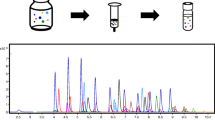Abstract
In clinical or forensic toxicology, general unknown screening procedures are used to identify as many xenobiotics as possible, belonging to numerous chemical classes. We present here a general unknown screening procedure based on liquid chromatography coupled with use of a single linear ion trap mass spectrometer, and focus on the identification of pesticides and/or metabolites in whole blood. After solid-phase extraction (SPE), the compounds of interest were separated using a reversed-phase column and identified by the mass spectrometer operated first in the full-scan mass spectrometry (MS) mode, in the positive and negative polarities, followed by MS2 and MS3 scanning of ions selected in data-dependent acquisition. The total scan time was 2.45 s. Two mass spectral libraries (MS2 and MS3), each of 450 spectra, were created for the 320 pesticides and metabolites detected after injection of pure solutions. Robustness of the spectra and matrix effects were studied and were satisfactory for the present application. Detection limits for the 320 compounds were studied by extracting 1 mL spiked blood at concentrations between 10 µg/L and 10 mg/L. If necessary, it was possible to decrease the detection limits of some compounds by 10–100-fold by scanning MS2 in only one polarity, owing to a shorter total scan time. However, at the same time, the detection specificity decreased as no confirmation could be recorded in the following MS3 scan and no information could be registered in the other polarity. So, in these rare cases, confirmation by another method was required.




Similar content being viewed by others
References
Fucci N, De Giovanni N, De Giorgio F, Liddi R, Chiarotti M (2006) Forensic Sci Int 156:102–105
Maurer HH (1992) J Chromatogr 580:3–41
Schönberg L, Grobosch T, Lampe D, Kloft C (2007) J Anal Toxicol 31:321–327
Sauvage FL, Saint-Marcoux F, Duretz B, Deporte D, Lachâtre G, Marquet P (2006) Clin Chem 52:1735–1742
Saint-Marcoux F, Lachâtre G, Marquet P (2003) J Am Soc Mass Spectrom 14:14–22
Marquet P (2002) Ther Drug Monit 24:125–33
Maurer HH (2007) Anal Bioanal Chem 388:1315–1325
Dulaurent S, Gaulier JM, Marquet P, Lachâtre G (2006) Acta Clin Belg 61:71–76
Dulaurent S, Gaulier JM, Baudel JL, Fardet L, Maury E, Lachâtre G (2008) Forensic Sci Int 176:72–75
Dulaurent S, Saint-Marcoux F, Marquet P, Lachâtre G (2006) J Chromatogr B 831:223–229
Hernández F, Sancho JV, Pozo OJ (2005) Anal Bioanal Chem 382:934–946
Bicker W, Lämmerhofer M, Linder W (2005) J Chromatogr B 822:160–169
Lehotay SJ, De Kok A, Hiemstra M, Van Bodegraven P (2005) J AOAC Int 88:595–614
Ortelli D, Edder P, Corvi C (2004) Anal Chim Acta 520:33–45
Mori H, Sato T, Nagase H, Takada K, Yamazaki F (1998) Jpn J Toxicol Environ Health 44:182–194
Schreiber A, Efer J, Engenwald W (2000) J Chromatogr A 869:411–425
Garcia-Reyes JF, Molina-Diaz A, Fernandez-Alba AR (2007) Anal Chem 79:307–321
Garcia-Reyes JF, Ferrer I, Thurman EM, Molina-Diaz A, Fernandez-Alba AR (2005) Rapid Commun Mass Spectrom 19:2780–2788
Josephs JL, Sanders M (2004) Rapid Commun Mass Spectrom 18:743–759
Chambers E, Wagrowski-Diehl DM, Lu Z, Mazzeo JR (2007) J Chromatogr B 852:22–34
World Health Organization (2005) The WHO recommended classification of pesticides by hazard and guidelines to classification 2004. Word Health Organization, Geneva
Dear GJ, James AD, Sarda S (2006) Rapid Commun Mass Spectrom 20:1351–1360
Schwartz JC, Senko MW, Syka JEP (2002) J Am Soc Mass Spectrom 13:659–669
Schenk FJ, Lehotay SJ, Vega V (2002) J Sep Sci 25:883–890
Fontanals N, Trammell BC, Galià M, Marcé RM, Iraneta PC, Borrull F, Neue UD (2006) J Sep Sci 29:1622–1629
Acknowledgements
The authors thank E. Genin and C. Dabadie (ThermoFisher Scientific France) for their technical support.
Author information
Authors and Affiliations
Corresponding author
Rights and permissions
About this article
Cite this article
Dulaurent, S., Moesch, C., Marquet, P. et al. Screening of pesticides in blood with liquid chromatography–linear ion trap mass spectrometry. Anal Bioanal Chem 396, 2235–2249 (2010). https://doi.org/10.1007/s00216-009-3443-z
Received:
Revised:
Accepted:
Published:
Issue Date:
DOI: https://doi.org/10.1007/s00216-009-3443-z




